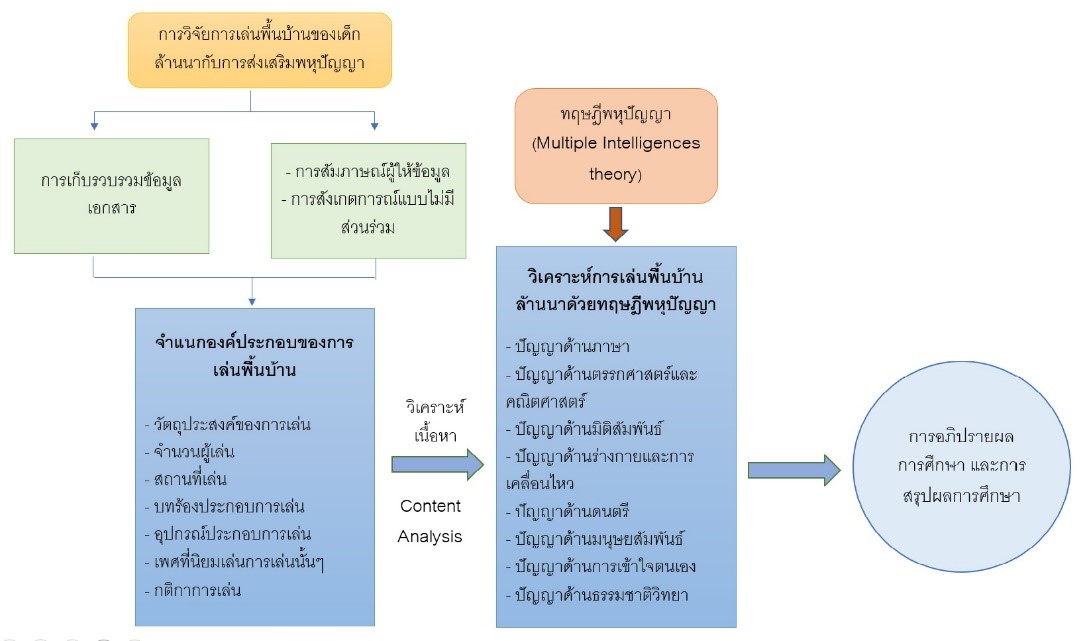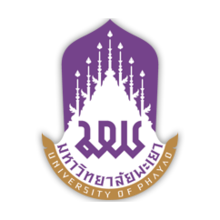The Lan Na Children’s Local Games and the Multiple Intelligences Encouragement
Keywords:
Children’s Local Games, Lan Na, Folklore, Theory of Multiple IntelligencesAbstract
This qualitative research aimed to study the elements of local games played by Lan Na children, and analyze how these games help encouraging the children’s skills
in accordance with Howard Gardner’s Theory of Multiple Intelligences. The analysis was based on the data of 145 types of Lan Na’s local games collected from the documents and from the fieldworks applying folklore methodology; the convenience and voluntary sampling method was applied to collect data from 20 key informants. The result revealed that the element of local games played by Lan Na children was composed of 7 components: 1) the objectives of the games, 2) the number of the players, 3) the playing venue, 4) the rule and the instruction, 5) the song lyrics (for singing along while playing games), 6) the equipment of the games, and 7) the gender of the game players. All types of Lan Na children’s local games could stimulate the children’s multiple intelligences. First, the bodily-kinesthetic was mostly found in all games. As for the interpersonal and the intrapersonal, they were usually found in tandem and in games played by more than 2 players or by team. Next, the linguistic-verbal and the musical were generally and concurrently found, but only in a few games and not obvious. Same as the logical-mathematical and the visual-spatial, they were also found only in some games and not distinct. Finally, the naturalist was generally related to the games requiring outdoor or natural playground. However, these games were less likely to be found at present due to the change
in environment and society. The result of this study could further benefit both the school and the parent; while the former could introduce these games in the physical education class, the later could apply these games in order to develop the children’s multiple intelligences in various dimensions.
References
เกศสุดา แสนนามวงษ์. (2559). การพัฒนารูปแบบการเรียนการสอนกิจกรรมแนะแนวโดยใช้ทฤษฎีพหุปัญญาเป็นฐานเพื่อพัฒนาทักษะชีวิต สำหรับนักเรียนชั้นมัธยมศึกษาปีที่ 1. วารสารราชพฤกษ์, 14(2), 91-98.
ทัดดาว ส่องแสงจันทร์ และคณะ. (2557). การพัฒนาเครื่องมือประเมินปัญญาทางภาษาตามทฤษฎีพหุปัญญาสำหรับเด็กปฐมวัย. วารสารการวัดผลการศึกษา มหาวิทยาลัยมหาสารคาม, 20(1), 88-102.
ธนลาวัณย์ เพียรค้า. (2561). การจัดหลักสูตรการศึกษาบนฐานทฤษฎีพหุปัญญาของโรงเรียนสาธิตมหาวิทยาลัยศรีนครินทรวิโรฒ ประสานมิตร(ฝ่ายมัธยม). วารสารเกษมบัณฑิต, 19(2), 169-181.
นฏกร ประมายันต์ และคณะ. (2558). การพัฒนาระบบการสอนตามแนวทฤษฎีพหุปัญญาบนเครือข่ายอินเตอร์เน็ท. วารสารมหาวิทยาลัยนราธิวาสราชนครินทร์, 7(1), 58-70.
เนตรดาว มุ่งหมาย, ประสาท เนืองเฉลิม, และประยูร วงศ์จันทรา. (2556). ผลการจัดการเรียนรู้วิทยาศาสตร์ตามแนวคิดพหุปัญญา เรื่อง บรรยากาศในชีวิตประจำวัน ชั้นมัธยมศึกษาปีที่ 1. วารสารมนุษยศาสตร์และสังคมศาสตร์ มหาวิทยาลัยพะเยา, 1(2), 2-9.
มนิษวาส จินตพิทักษ์ และธิตินัดดา จินาจันทร์. (15 ตุลาคม 2556). การสูญหายของการละเล่นพื้นบ้านของเด็กล้านนา “มรดกวัฒนธรรมเอเชียที่ถูกลืม : รู้รักษา สืบสาน” (Asian Forgotten Heritage: Perception, Preservation and Presentation). ICOMOS Thailand. เชียงใหม่: คณะสถาปัตยกรรมศาสตร์ มหาวิทยาลัยเชียงใหม่.
มูลนิธิสารานุกรมวัฒนธรรมไทย ธนาคารไทยพาณิชย์. (2542). สารานุกรมวัฒนธรรมไทยภาคเหนือ เล่ม 1-11. กรุงเทพฯ: มูลนิธิสารานุกรมวัฒนธรรมไทย.
มัลลิกา คณานุรักษ์. (2550). คติชนวิทยา. กรุงเทพฯ: โอเดียนสโตร์.
เรณู อรรฐาเมศร์. (2535). คติชนวิทยา. เชียงใหม่: โครงการพัฒนาตำรา คณะมนุษยศาสตร์และสังคมศาสตร์ สถาบันราชภัฏเชียงใหม่.
วาสนา จักร์แก้ว และคณะ. (2559). การประยุกต์ใช้ของเล่นพื้นบ้านล้านนา: เพื่อส่งเสริมพัฒนาการเด็กปฐมวัย. วารสารการวิจัยกาสะลองคำ, 10(2), 27-36.
วัฒนา ปุญญฤทธิ์. (2553). การเล่นที่ไม่ใช่เรื่องเล่น ๆ. โครงการบริการนวัตกรรมทางวิชาการด้านการศึกษาปฐมวัย. กรุงเทพฯ: มหาวิทยาลัยราชภัฏสวนดุสิต.
Cemore, J. J. (2005). What is make-believe play?: preschool teachers’ perspectives. USA: Iowa State University.
Davis, K., [et al]. (2011). The Theory of Multiple Intelligences, in Robert J. Sternberg, The Cambridge Handbook of Intelligence (2nd edition). USA: Cambridge University Press.
Kostelnik, M J., [et al]. (1998). Guiding Children’s Social Development. USA: Michigan State University.
Van Hoorn, J., [et al]. (2003). Play at the Center of the Curriculum. USA: Pearson Education, Inc.

Downloads
Published
How to Cite
Issue
Section
License
Copyright (c) 2023 Phayao University

This work is licensed under a Creative Commons Attribution-NonCommercial-NoDerivatives 4.0 International License.
ผู้นิพนธ์ต้องรับผิดชอบข้อความในบทนิพนธ์ของตน มหาวิทยาลัยพะเยาไม่จำเป็นต้องเห็นด้วยกับบทความที่ตีพิมพ์เสมอไป ผู้สนใจสามารถคัดลอก และนำไปใช้ได้ แต่จะต้องขออนุมัติเจ้าของ และได้รับการอนุมัติเป็นลายลักษณ์อักษรก่อน พร้อมกับมีการอ้างอิงและกล่าวคำขอบคุณให้ถูกต้องด้วย
The authors are themselves responsible for their contents. Signed articles may not always reflect the opinion of University of Phayao. The articles can be reproduced and reprinted, provided that permission is given by the authors and acknowledgement must be given.







